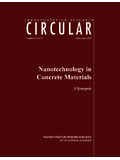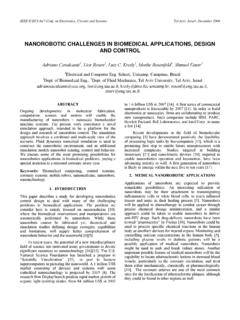Transcription of Review of the adequacy of current regulatory …
1 Health and Safety ExecutiveReview of the adequacy of current regulatoryregimes to secure effective regulation ofnanoparticles created by nanotechnologyThe regulations covered by HSEC ontents1 The reason for the Review 22 Background information 23Is a nanomaterial new and hence notifiable under NONS? 44 NONS Regulations: Issues for a notifiable material 55 Chemicals (Hazard Information and Packaging for Supply) Regulations (CHIP)76 Workplace risk management 87 Other specific legislation (EU Existing Substances Regulations; BiocidalProducts Regulations; Major Hazard (COMAH) legislation) 128 REACH 139 Conclusions 14 Appendices:IConclusions of the Royal Society and Royal Academy of Engineering report Nanoscience and nanotechnologies: opportunities and uncertainties 15 IISummary from HSE (2004) Review : A Review of the toxicity of particles that areintentionally produced for use in nanotechnology applications, seen from anoccupational health perspective 17 III Summary from HSE (HSL report 2004): Literature Review explosion hazardsassociated with nanopowders 18IV Summary from HSE-sponsored research (2004): Nanoparticles.
2 Anoccupational hygiene Review 19 References 22 Further information 221 The reason for the review1 Recommendations 8 and 11 of the Royal Society and Royal Academy ofEngineering report Nanoscience and nanotechnologies: opportunities anduncertainties (see Appendix I) make reference to the need for government toconsider the adequacy of regulatory frameworks in relation to nanoparticles,especially nanoparticles that will arise from the application of nanotechnology . Thegovernment accepted these recommendations. Accordingly, each governmentdepartment has undertaken to analyse and document how current regulations forwhich they have responsibility accommodate nanoparticles.
3 This is HSE s analysisin relation to its responsibilities. The aim of this Review is therefore to set out anddiscuss issues arising in relation to the following: whether or not nanoparticles are covered by the scope of the regulations forwhich HSE has responsibility; and whether or not the requirements of these regulations are appropriate andsufficient to protect human health in relation to occupational exposure tonanoparticles (this does not include the availability of advice relevant tonanoparticles).2 Background information 2 With respect to nanomaterials, HSE has critically reviewed the availableinformation on their physicochemical and toxicological hazards of relevance in theworkplace and the occupational exposure situation (see summaries attached asAppendices II, III and IV).
4 The reviews focused on poorly soluble or insolubleparticles (including fibres) intentionally generated to have applications innanotechnology, with one or more physical dimension(s) being less than 100 nm( micrometre). These reports indicate that there are very few good qualitystudies on novel nanomaterials of relevance to the assessment of human healthhazards or exposure, although some limited but useful information is also availableon more familiar materials reduced in size to the nanoscale. 3 Given the paucity of information available and the concerns raised by some ofthe data that does exist, a cautious approach to risk management has beenrecommended in an information note aimed at researchers and developerspotentially exposed to nanomaterials (HSE, 2004).
5 Overview of current legal framework4 Legislation to regulate the health and safety hazards of industrial chemicals andthe risks they pose in the workplace has been developed and standardised acrossthe European Union (EU); these regulations have been accommodated in the UKunder the umbrella of the Health and Safety at Work Act 1974 (the HSW Act).There are also other agreements determined at a global level that may influencethese EU regulations, for instance the Globally Harmonised Scheme forclassification and labelling and the OECD guidelines for the testing of chemicals. Inreviewing the current legislation the reader should be aware that the EU chemicalspolicy is on the verge of a major shift to a different regulatory framework based onthe Registration, Evaluation and Authorisation of Chemicals (REACH) which willhave consequences for all the current legislation addressed in this Review .
6 Hence,at this time, there is little opportunity to modify the current legislation. It is alsopremature to specify precisely how future REACH-related legislation wouldaccommodate the relevant issues identified in this Review , as the negotiationsshaping the new legislation are 22 pagesReview of the adequacy of current regulatory regimes to secure effective regulation ofnanoparticles created by nanotechnology Health and Safety Executive3of 22 pagesReview of the adequacy of current regulatory regimes to secure effective regulation ofnanoparticles created by nanotechnology Health and Safety Executive5 The current regulatory framework and the roles involved can be summarised aimed at suppliers6EU Directives implemented in the UK by the Chemicals (Hazard Information andPackaging for Supply) Regulations (CHIP)
7 Require that suppliers of chemicals shouldseek out and convey information to the recipients on the physicochemical (egflammability) and toxicological hazards of their chemicals. This is done through EU-standardised classification and labelling (C&L) and Safety Data Sheets (SDS). Inrecognition of the dearth of reliable hazard information on many industrial chemicals,the 7th Amendment to the EU Dangerous Substances Directive (DSD) implementedin the UK as the Notification of New Substances (NONS) Regulations, requires(among other things) standardised testing of hazardous properties of industrialchemicals new to the market.
8 There is also a responsibility on suppliers to addressthe downstream risks and their management. Since the early 1990s there has alsobeen an EU-wide attempt to capture and improve the hazard information availablefor older industrial chemicals, and to assess the risks to health and safety via theExisting Substances Regulation (ESR). However, activity under this regulation is nowwinding down, in anticipation of the future REACH regime , which will subsume thesesupply-side regulations and extend the principles of supplier responsibility further. 7 The supply of biocides is addressed by EU Directive 98/8/EC which establishesa regulated single European market in biocides based on risk evaluation andharmonised authorisation.
9 In 2001 this Directive was implemented as the BiocidalProducts Regulations (BPR) in Great Britain and its equivalent regulation in NorthernIreland. Over time, these Regulations will replace the current UK national approvalscheme for non-agricultural pesticides under the Control of Pesticides Regulations(1986 as amended) that remain in force until substances have been assessed underthe new regulations. Under BPR and its equivalent regulations elsewhere in the EU,industry will be required to submit data on the active substance and a representativeformulation which addresses the hazardous properties, classification and labellingand necessary risk management procedures, which will be evaluated by MemberStates (MS) and a risk assessment conducted.
10 Evaluations are then harmonised andmade usable across the EU under the principle of mutual acceptance of of chemicals(and manufacturers/suppliers in relation to theirown sites) are responsible for understanding their local situation. Using theinformation from suppliers, they should assess and appropriately manage the extentof worker exposure to hazardous chemicals so as to eliminate, or at least minimise,the health and safety risks so far as is reasonably practicable . This is a requirementof the EU Chemical Agents Directive and the Carcinogens Directive transposed intothe UK legislation in the Control of Substances Hazardous to Health Regulations(COSHH) and Dangerous Substances and Explosive Atmospheres Regulations(DSEAR).

















